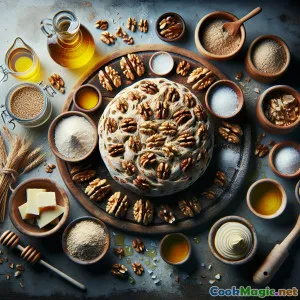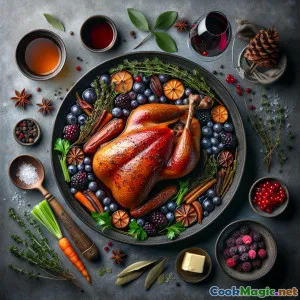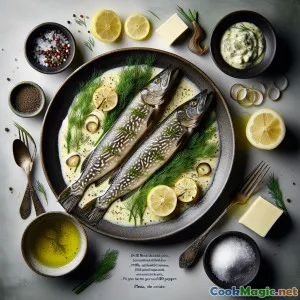
에메랄드 포드할레 호밀과 호두 시골 빵
(Emerald Podhale Rye & Walnut Country Bread)
(0 리뷰)재료
-
300 grams 호밀 가루
(돌로 간 호밀가루 또는 통밀 호밀가루)
-
200 grams 빵용 밀가루
(구조를 위한 고단백 화이트 빵용 밀가루)
-
100 grams 깨진 호두
(대충 썬 것)
-
2 teaspoons 캐러웨이 씨앗
(선택 가능하지만 전통적)
-
7 grams 활성 건조 효모
(1 표준 포장)
-
10 grams 바다 소금
(고운 바닷소금 선호)
-
1 tablespoon 꿀
(깊은 풍미와 은은한 단맛을 더합니다; 대체재로 메이플 시럽을 사용하세요.)
-
350 ml 따뜻한 물
(효모 활성화를 위해 약 38–40°C.)
-
1 tablespoon 올리브 오일
(수분 유지와 크러스트 색을 돕습니다)
(돌로 간 호밀가루 또는 통밀 호밀가루)
(구조를 위한 고단백 화이트 빵용 밀가루)
(대충 썬 것)
(선택 가능하지만 전통적)
(1 표준 포장)
(고운 바닷소금 선호)
(깊은 풍미와 은은한 단맛을 더합니다; 대체재로 메이플 시럽을 사용하세요.)
(효모 활성화를 위해 약 38–40°C.)
(수분 유지와 크러스트 색을 돕습니다)
영양 정보
- 인분: 8
- 1인분 크기: 빵 1/8 조각(대략 75 g)
- Calories: 224 kcal
- Carbohydrates: 39 g
- Protein: 6 g
- Fat: 5 g
- Fiber: 4 g
- Sugar: 2 g
- Sodium: 295 mg
- Cholesterol: 0 mg
- Calcium: 22 mg
- Iron: 1.4 mg
조리법
-
1 - 이스트 활성화:
따뜻한 물에 이스트와 꿀을 섞으세요(사용하는 경우). 거품이 생길 때까지 10분간 두세요.
-
2 - 건조 재료 혼합:
큰 그릇에 호밀가루, 빵용 밀가루, 소금 그리고 캐러웨이 씨앗(사용하는 경우)을 넣고 섞으세요.
-
3 - 모양 내는 반죽:
건조한 재료 위에 이스트 혼합물과 올리브 오일(사용하는 경우)을 부으세요. 단단한 숟가락으로 섞일 때까지 저으세요.
-
4 - 호두를 넣고 반죽하세요:
호두를 넣고 잘 섞으세요. 반죽을 가볍게 밀가루를 뿌린 표면에 옮겨 매끈해질 때까지 반죽하세요(7–10분).
-
5 - 1차 발효:
반죽을 기름칠한 그릇에 넣으세요. 뚜껑을 덮고, 바람이 잘 통하지 않는 곳에서 두 배로 부풀 때까지 발효시킵니다(약 2시간).
-
6 - 모양 잡기와 2차 발효:
반죽을 눌러 가스를 빼고, 둥근 덩어리로 모양을 잡습니다. 베이킹 페이퍼 위에 놓거나 밀가루를 뿌린 발효 바구니에 넣으세요. 덮고 부풀 때까지 발효시키며, 약 1.5시간.
-
7 - 오븐 예열하기:
마지막 발효 단계에서 오븐을 230°C(446°F)로 예열하고 그 안에 더치 오븐을 놓으세요.
-
8 - 칼집을 내고 굽기:
뜨거운 더치 오븐에 반죽을 살살 옮겨 담고 표면에 추가 밀가루를 뿌린 뒤 위에 칼집으로 긋습니다. 뚜껑을 닫고 35분간 굽고, 그다음 뚜껑을 열어 10분 더 굽고 깊은 크러스트를 얻으세요.
-
9 - 식히고 제공하기:
빵을 꺼내 와이어 랙 위에서 최소 30분간 식힌 뒤, 질감의 발달을 마무리하기 위해 자르십시오.
따뜻한 물에 이스트와 꿀을 섞으세요(사용하는 경우). 거품이 생길 때까지 10분간 두세요.
큰 그릇에 호밀가루, 빵용 밀가루, 소금 그리고 캐러웨이 씨앗(사용하는 경우)을 넣고 섞으세요.
건조한 재료 위에 이스트 혼합물과 올리브 오일(사용하는 경우)을 부으세요. 단단한 숟가락으로 섞일 때까지 저으세요.
호두를 넣고 잘 섞으세요. 반죽을 가볍게 밀가루를 뿌린 표면에 옮겨 매끈해질 때까지 반죽하세요(7–10분).
반죽을 기름칠한 그릇에 넣으세요. 뚜껑을 덮고, 바람이 잘 통하지 않는 곳에서 두 배로 부풀 때까지 발효시킵니다(약 2시간).
반죽을 눌러 가스를 빼고, 둥근 덩어리로 모양을 잡습니다. 베이킹 페이퍼 위에 놓거나 밀가루를 뿌린 발효 바구니에 넣으세요. 덮고 부풀 때까지 발효시키며, 약 1.5시간.
마지막 발효 단계에서 오븐을 230°C(446°F)로 예열하고 그 안에 더치 오븐을 놓으세요.
뜨거운 더치 오븐에 반죽을 살살 옮겨 담고 표면에 추가 밀가루를 뿌린 뒤 위에 칼집으로 긋습니다. 뚜껑을 닫고 35분간 굽고, 그다음 뚜껑을 열어 10분 더 굽고 깊은 크러스트를 얻으세요.
빵을 꺼내 와이어 랙 위에서 최소 30분간 식힌 뒤, 질감의 발달을 마무리하기 위해 자르십시오.
에메랄드 포드할레 호밀과 호두 시골 빵 :에 대한 자세한 정보
Introduction
Podhale Rye and Walnut Rustic Bread is a tribute to rustic Eastern European country loaves, inspired by the earthy harvests and simple but profound home baking traditions of the Podhale region in southern Poland. This bread encapsulates Old World culinary wisdom—a time when bread was nourishment, centerpiece, and pride for rural families across Polish highlands.
The heady aroma of rye, pulsing with nutty sweetness from walnuts and a brush of caraway, harkens back to bread you’d encounter in mountain village markets or alongside cheese and mushroom stews shared at timber-clad inns. What makes this recipe unique is its blend of rich rye with wheat, providing an accessible crumb for modern bakers without losing Old Country character. The addition of walnuts not only amplifies texture but harnesses Podhale’s tradition of foraging for nuts and herbs.
Tips, Notes & Substitutions
- Flour: Always use the best-quality rye flour you can get; stone-ground gives an authentic, earthy taste and solid nutrition. In a pinch, dark rye can be blended with all-purpose, but ratios may need tweaking as rye absorbs more moisture.
- Nuts: Walnuts should be coarsely chopped; their visiting crunch provides dynamic mouthfeel in each bite. If walnuts aren’t available, hazelnuts (common to Carpathia) are a tasty substitute.
- Crust: For an extra crisp, crackly crust, bake the bread in a pre-heated Dutch oven and leave the lid off for the final 10 minutes for deeper color—and a mesmerizing aroma.
- Salt & Sweeteners: Finer salt disperses better; honey isn’t vital but disguises the sometimes-acidic rye and boosts browning. Maple syrup lends a smoky undertone.
- Caraway: While optional, caraway is time-honored in Central European rye loaves and lends an unmistakeable tingle and deformal bread-smell many Eastern Europeans associate with home.
History & Cultural Significance
In the foothills of the Tatra mountains, bread is more than a daily bake. Once a way of life for highlanders—shepherds, cheese makers, artisans—the Podhale region’s dark breads fueled their hard, windy, communal living. Grain had to be stretched; supplements like mashed potato, seeds, and sometimes whatever orchard windfall (namely walnuts) could enrich sparse cupboards. Sundays and harvest feasts still see loaves cross icons and prayer candlelight, a centerpiece of gratitude and togetherness.
This take on the Podhale loaf is a blend of tradition and modern comfort—combining enough wheat flour for a soft crumb with distinct rye tang, then adding encased, roasted walnuts that offer unexpected excitement as you slice through.
Personal Thoughts & Serving Ideas
This bread, while sublime warm and buttered, reaches its zenith when paired with smoked cheese (try Oscypek), thick honey, or cold mountain trout pâtés. Leftover slices transform into hearty toast or grids of rye-and-walnut salads. In winter, I love it next to borscht; in summer, simply torn apart under alpine wildflower meadows.
What’s magical is how the nuts caramelize as the bread bakes, scenting the crust and giving a depth not found in mass-produced loaves. It’s as deeply nested in Polish tradition as it is friendly to modern, health-focused kitchens that value fiber, ancient grains, their slow nutrition, and their careful stories.
Final Note
Bake this bread not just for its taste, but because its aroma alone can unite friends and neighbors for comfort and good talks. Both simple and sophisticated, the Podhale Rye and Walnut Rustic Bread invites you to slow down and savor.
























